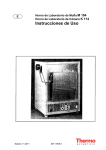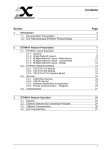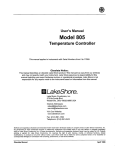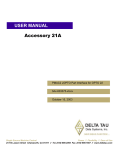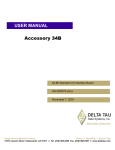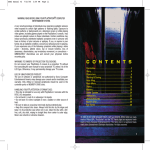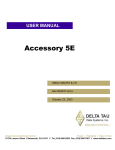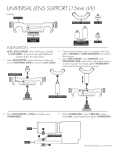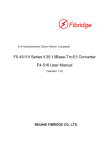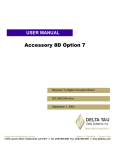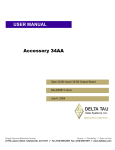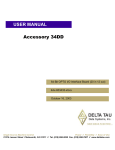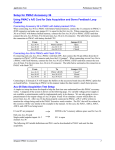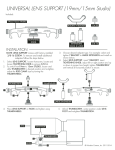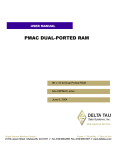Download ^1 USER MANUAL ^2 Accessory 18
Transcript
^1 USER MANUAL ^2 Accessory 18 ^3 Thumbwheel Multiplexer ^4 3Ax-602178-xUxx ^5 October 1, 2003 Single Source Machine Control Power // Flexibility // Ease of Use 21314 Lassen Street Chatsworth, CA 91311 // Tel. (818) 998-2095 Fax. (818) 998-7807 // www.deltatau.com Copyright Information © 2003 Delta Tau Data Systems, Inc. All rights reserved. This document is furnished for the customers of Delta Tau Data Systems, Inc. Other uses are unauthorized without written permission of Delta Tau Data Systems, Inc. Information contained in this manual may be updated from time-to-time due to product improvements, etc., and may not conform in every respect to former issues. To report errors or inconsistencies, call or email: Delta Tau Data Systems, Inc. Technical Support Phone: (818) 717-5656 Fax: (818) 998-7807 Email: [email protected] Website: http://www.deltatau.com Operating Conditions All Delta Tau Data Systems, Inc. motion controller products, accessories, and amplifiers contain static sensitive components that can be damaged by incorrect handling. When installing or handling Delta Tau Data Systems, Inc. products, avoid contact with highly insulated materials. Only qualified personnel should be allowed to handle this equipment. In the case of industrial applications, we expect our products to be protected from hazardous or conductive materials and/or environments that could cause harm to the controller by damaging components or causing electrical shorts. When our products are used in an industrial environment, install them into an industrial electrical cabinet or industrial PC to protect them from excessive or corrosive moisture, abnormal ambient temperatures, and conductive materials. If Delta Tau Data Systems, Inc. products are directly exposed to hazardous or conductive materials and/or environments, we cannot guarantee their operation. PMAC Accessory 18 Table of Contents INTRODUCTION ........................................................................................................................................ 1 ACC-18 Option 1: (DB37 Pin Connector) ................................................................................................ 1 ACC-18 Option 2: (Dip Switches) ............................................................................................................ 1 ACC-18 Option 3 ....................................................................................................................................... 1 ACC-18 Option 4: (Thumbwheels)........................................................................................................... 2 ACC-18 Option 5: (External Power Connector) ....................................................................................... 2 ACC-18 Option 6: (Molex Connectors) .................................................................................................... 2 CONNECTORS............................................................................................................................................ 3 J1 ................................................................................................................................................................ 3 J2 ................................................................................................................................................................ 3 TB1 ............................................................................................................................................................ 3 TB2 ............................................................................................................................................................ 3 J3 ................................................................................................................................................................ 3 THUMBWHEEL INSTALLATION .......................................................................................................... 4 DIP SWITCH INSTALLATION ................................................................................................................ 5 MULTIPLEX ADDRESS MAP .................................................................................................................. 7 Table 1 (Address Relationship).................................................................................................................. 7 Table 2 (Multiplex Memory Map) ............................................................................................................. 8 READING DATA FROM ACC-18............................................................................................................. 9 TWD Definition (BCD Thumbwheel-Multiplexer Definition) .................................................................. 9 TWB Definition (Binary Thumbwheel-Multiplexer Definition)................................................................ 9 JUMPERS AND LEDS .............................................................................................................................. 11 CONNECTOR PINOUTS ......................................................................................................................... 13 DB and Terminal Block Connectors ........................................................................................................ 13 J1 and J2 (DB 37-Pin Connectors)...................................................................................................... 13 TB1 (External Power Supply Connector) ............................................................................................ 14 J3 ......................................................................................................................................................... 14 TB2 ...................................................................................................................................................... 14 SUMMARY................................................................................................................................................. 15 Power Requirements............................................................................................................................ 15 PMAC THUMBWHEEL USE .................................................................................................................. 16 DIAGRAMS................................................................................................................................................ 17 Table of Contents i PMAC Accessory 18 ii Table of Contents PMAC Accessory 18 INTRODUCTION The Thumbwheel Multiplexer, Accessory 18 (ACC-18), is a printed circuit board which provides the required circuitry for reading 16 thumbwheels or 64 DIP switches by PMAC. The connector JTHW (J3) on PMAC's main board is specifically provided for interface with ACC-18. Up to 32 ACC-18s can be daisy-chained to permit the reading of 512 thumbwheels (or 2048 binary TTL level inputs) by PMAC. The exact number of thumbwheel and/or DIP switches ordered with each ACC-18 is user selectable. The user must select how many thumbwheel digits (switches) are needed. A maximum of 16 switches may be installed on each ACC-18. The locations of the thumbwheel switches on the board should also be specified. In addition, if DIP switches are required on the same ACC-18, care should be taken to avoid multiplex memory map conflict with the selected thumbwheels (see sections on thumbwheel and DIP switch installation below). To facilitate the selection process, an Order Form is provided for ACC-18 (A sample of this Form is at the end of this Manual). ACC-18 comes with the following options: ACC-18 Option 1: (DB37 Pin Connector) Daisy-chain Expansion Connector - This is a DB37 connector (J2), which allows for the connection of more than one ACC-18 to one PMAC through its JTHW connector. Each ACC-18 board has an address selector 5-position DIP switch (SW9). The 5-bit address setting for each ACC-18 determines its specific address along the daisy chain. For each ACC-18 connected to PMAC, the switch must be set according to the addressing numbers shown in table 1. A 6” cable is provided with this option for the connection between any two adjoining ACC-18s (J2 of ACC18 closer to PMAC should be connected to J1 of the next ACC-18). ACC-18 Option 2: (Dip Switches) Dip Switches, 8 Position, P/N 76SB08S or 76SB08 by Grayhill- This option is useful for the application of the multiplexer board to read individual binary bits. The provided DIP switches can serve as general purpose (program dependent) input switches to PMAC via ACC-18. Each DIP switch pack comes in 8 bits. A total of eight DIP switch packs may be installed on one ACC-18 board (assuming no thumbwheel switches are installed on the same ACC-18). This gives 64 individual bits configurable in groupings of 1 to 32 bits. For a direct parallel read of these switches by PMAC, use the command TWB (see PMAC’s Manual). A DIP switch pack may not be installed at a position, which shares the same PMAC address with an installed thumbwheel switch (e.g., TS1/TS2 and SW1 should not be installed on the same ACC-18). ACC-18 Option 3 N/A to PMAC Introduction 1 PMAC Accessory 18 ACC-18 Option 4: (Thumbwheels) This option provides the actual thumbwheels and the sockets for installing the thumbwheels on ACC-18. Factory installation of the sockets and the thumbwheels is the standard procedure whenever one or more thumbwheels are ordered together with an ACC-18. Otherwise, sockets may be soldered by the customer at desired locations on the board (each location corresponds to a specific thumbwheel multiplex address for PMAC). The thumbwheels are then plugged into the sockets. Thumbwheels by Cherry or equivalent P/N T20-02A, Tie Rod P/N 012-0347, Fastner P/N 012-0744, End Caps P/N 009-1153. Thumbwheel sockets by Edac or equivalent P/N 307006-501-104, alternative 306-006-521-101 . ACC-18 Option 5: (External Power Connector) External Power Connector- This option allows for the connection of an external +5V power supply to ACC-18. Without this option, J1 brings in PMAC's +5V power supply for the on-board logic through the supplied 6’ flat cable. If a longer cable is used, there may be an unacceptable drop in the supply voltage. In such situations, Option 5 should be ordered. In general, Option 5 is recommended for applications in which ACC-18 is located too far (more than 20 feet) away from PMAC. ACC-18 Option 6: (Molex Connectors) Molex Connectors and Mates - This Option allows for the connection of remotely located thumbwheels (or any other binary switch input) to an ACC-18. Molex or equivalent 6 pin connectors, male and female, with male P/N 09-06-1061 in the multiplexer’s TS1 to TS16 connector slots and the female, P/N 09-50-7061 with contact pins 08-50-0106 terminating the cable from the remote thumbwheels. 2 Introduction PMAC Accessory 18 CONNECTORS Refer to the schematic layout diagram of ACC-18 for all connectors and their locations on the board. A listing for each connector’s pin definition begins on page 13 of this manual. J1 This DB37 connector provides the link between PMAC'S JTHW (J3) and ACC-18 through the supplied flat cable. For multiple ACC-18s, J1 provides the connection to J2 of the ACC-18 daisychained closer to PMAC (see connection diagram). J2 This DB37 connector comes with Option 1. J2 provides the link between two adjoining ACC-18s (see connection diagram). TB1 This is a 6-pin screw-down terminal block, which comes with ACC-18’s Option 5 for the connection of external power. This connector also brings in an external PMAC reset input. TB2 N/A to PMAC. J3 N/A to PMAC. Connectors 3 PMAC Accessory 18 THUMBWHEEL INSTALLATION The thumbwheel sockets (or the Molex connectors for remote connections) may be installed at any of the 16 "TS" locations on an ACC-18. Each thumbwheel switch installed on a TS location represents one BCD digit. Starting from an odd number, any two adjoining TS locations form a unique multiplexed JTHW PMAC address for an 8-bit number. For each ACC-18 the TS1/TS2 pair has the lowest address on PMAC’s JTHW memory map. The TS15/TS16 pair has the highest address (odd numbered switches form the low nibbles). Example: On an ACC-18, which is DIP switch selected as the board #1 (see the first entry in table 1), the address of the socket location TS1 is that of the low nibble (0) of the first 8-bit number. On a second ACC-18, which is selected as the board #2, the address of socket location TS8 is that of the high nibble of the 12th (8+4) 8-bit number (see Table #1). PMAC’s specific BCD thumbwheel read command, TWD, can read multiple-digit BCD numbers (the maximum number of BCD digits read by one TWD command is 12). When using the TWD read format for multiple digit numbers, the thumbwheel switches should be located in contiguous TS locations with the most significant BCD thumbwheel switch installed in either the low or the high nibble of the lowest addressed location. The TWD read command automatically switches the data between the low and the high nibbles of each 8-bit addressed number such that the most significant decimal digit is always read from the thumbwheel to the far left of others forming the multiple digit number. In addition, DIP switches should not be installed in locations with the same multiplex addresses (see Table 2 for the shared addresses between the thumbwheel and the DIP switches on each ACC-18 board). Example: If an 8 digit number is to be read through 8 BCD thumbwheel switches on one ACC18, the most significant digit's thumbwheel may be located in TS1, or TS2,. . ., or TS8. The corresponding next most significant digit should be located in TS2, or TS3,..., or TS9 respectively. Also, the corresponding least significant digit for this number should be installed in TS8, or TS9, or TS16 respectively. In addition, no DIP switches should be installed in any location with an address conflict with the selected TS locations. Note Whenever an ACC-18 is ordered with one or more Option 4s, the switches and the sockets will be factory installed according to the Order Form specifications by the customer. 4 Thumbwheel Installation PMAC Accessory 18 DIP SWITCH INSTALLATION The DIP switch sockets may be installed in any of the eight byte-wide "SW" locations (SW1 to SW8) on each ACC-18 board. Each 8-bit DIP switch pack installed on a SW location can represent 8 bits of an integer number, or eight 1-bit binary numbers, or any combination in between. Each switch has a unique multiplexed JTHW PMAC address with respect to other DIP switches. For each ACC-18 SW1 has the lowest address on the PMAC's JTHW memory map (corresponding to TS1/TS2 address). SW8 has the highest address (corresponding to TS15/TS16 address). Thus, care should be taken to avoid addressing conflicts whenever both DIP switches and thumbwheel switches are used on the same ACC-18 board (i.e. thumbwheels on TS1/TS2 should not be installed if DIP switches on SW1 are installed). PMAC's specific binary thumbwheel read command, TWB, can read multiple DIP switches as fixed-point (integer) numbers. The maximum number of binary bits read by one TWB command is 32. For multiple digit numbers the DIP switch packs should be located in contiguous SW locations, with the most significant 8-bit DIP switch installed at the highest address. Note The most significant data line is connected to the DIP switch number 8 within each DIP switch pack. Example: To read a 16-bit binary number via two 8-bit DIP switch packs, the most significant 8bit pack may be installed in locations SW2, or SW4, or SW8. The least significant 8-bit pack should be installed in locations SW1, or SW3, or SW7 respectively. In addition, no thumbwheel switches should be installed in sockets with address conflicts with the selected DIP switch locations. Note Whenever an ACC-18 is ordered with one or more Option 2s, the switches and the sockets will be factory installed according to the Order Form specification by the customer. DIP Switch Installation 5 PMAC Accessory 18 6 DIP Switch Installation PMAC Accessory 18 MULTIPLEX ADDRESS MAP Each ACC-18 occupies 8 bytes of address space on the PMAC's JTHW multiplex memory space. This memory space is 8-bit wide, providing the ability to daisy-chain 32 (256/8) ACC-18s together. The 5-bit DIP switch, SW9, determines the address of each ACC-18 board on the allocated memory space. Table 1 shows how SW9 should be set for one or more ACC-18 boards connected to the same PMAC. Table 2 shows the addresses of the thumbwheel and the DIP switch sockets within each ACC-18 board. Table 1 (Address Relationship) Byte SW9 DIP SWITCH SETTING Low Nibble High Nibble 1 2 3 4 5 #1 0-3 4-7 ON ON ON ON ON #2 8-11 12-15 ON ON ON ON OFF #3 16-19 20-23 ON ON ON OFF ON #4 24-27 28-31 ON ON ON OFF OFF #5 32-35 36-39 ON ON OFF ON ON #6 40-43 44-47 ON ON OFF ON OFF #7 48-51 52-55 ON ON OFF OFF ON #8 56-59 60-63 ON ON OFF OFF OFF #9 64-67 68-71 ON OFF ON ON ON #10 72-75 76-79 ON OFF ON ON OFF #11 80-83 84-87 ON OFF ON OFF ON #12 88-91 92-95 ON OFF ON OFF OFF #13 96-99 100-103 ON OFF OFF ON ON #14 104-107 108-111 ON OFF OFF ON OFF #15 112-115 116-119 ON OFF OFF OFF ON #16 120-123 124-127 ON OFF OFF OFF OFF #17 128-131 132-135 OFF ON ON ON ON #18 136-139 140-143 OFF ON ON ON OFF #19 144-147 148-151 OFF ON ON OFF ON #20 152-155 156-159 OFF ON ON OFF OFF #21 160-163 164-167 OFF ON OFF ON ON #22 168-171 172-175 OFF ON OFF ON OFF #23 176-179 180-183 OFF ON OFF OFF ON #24 184-187 188-191 OFF ON OFF OFF OFF #25 192-195 196-199 OFF OFF ON ON ON #26 200-203 204-207 OFF OFF ON ON OFF #27 208-211 212-215 OFF OFF ON OFF ON #28 216-219 220-223 OFF OFF ON OFF OFF #29 224-227 228-231 OFF OFF OFF ON ON #30 232-235 236-239 OFF OFF OFF ON OFF #31 240-243 244-247 OFF OFF OFF OFF ON #32 248-251 252-255 OFF OFF OFF OFF OFF The daisy-chain board address relationship with respect to the 5-bit (SW9) DIP position setting. Note: ON=CLOSED, OFF=OPEN. To turn "off" a switch, push down on the "open" side. To turn "on" a switch, push down on the "numbered" side. Board # Multiplex Address Map 7 PMAC Accessory 18 Table 2 (Multiplex Memory Map) ACC-18 Multiplex Address Corresponding Thumbwheel Switch Number MS Nibble LS Nibble Corresponding DIP Switch Number Byte #1 TS2 TS1 SW1 Byte #2 TS4 TS3 SW2 Byte #3 TS6 TS5 SW3 Byte #4 TS8 TS7 SW4 Byte #5 TS10 TS9 SW5 Byte #6 TS12 TS11 SW6 Byte #7 TS14 TS13 SW7 Byte #8 TS16 TS15 SW8 The multiplex memory map for each ACC-18. Note: The address of DIP switches in a given row conflict with those for the thumbwheel switches in the same row. Therefore, for a given byte address, either DIP switches or thumbwheels switches may be installed. 8 Multiplex Address Map PMAC Accessory 18 READING DATA FROM ACC-18 There are two special format M-variables for reading the data from an ACC-18: TWD and TWB. These special PMAC M-variables along with the general M-variable definition formats are described in the main PMAC Manual. Also, included are the details for the use of the Mvariables in user programs. The reader should refer to the main PMAC Manual for examples of motion and PLC programs using M-variables. In this section, a brief description of the two special thumbwheel board M-variable definitions is given. TWD Definition (BCD Thumbwheel-Multiplexer Definition) This command causes PMAC to define the specified M-Variable or range of variables to point to a set of binary-coded-decimal digits multiplexed on the thumbwheel port with accessory 18 or compatible hardware. M{constant}->TWD:{m-plex address},{offset},{size}[.{dp}],{format} {m-plex address} is an integer constant in the range 0 to 255 corresponding to the byte within the 256-byte wide JTHW address space containing the most significant digit (nibble) of thumbwheel data; {offset} is either 0 or 4. The Offset is 0 when the most significant digit is in the low address nibble (odd numbered TS switches). The Offset is 4 when the most significant digit is in the high address nibble (even numbered TS switches). {size} is the number of digits. The minimum number of digits is 1. The maximum number of digits is 12; {dp} is the number of thumbwheel digits taken as being to the right of the decimal point (0 to 8 ; default is 0); {format} is either U for unsigned, or S for signed. If it is signed, the least significant bit of the most significant digit is taken as the sign bit (the rest of the most significant digit is ignored). Example: To define (assign to) the M-variable 123, the value of multiple thumbwheels via the TWD command may be written: M123->TWD:4,0,8.3,U This PMAC M- variable definition means that the most significant digit is at multiplex address 4, low nibble (left digit); there are 8 digits, 3 of which are fractional; and it is always interpreted as a positive value. This corresponds to eight thumbwheel digits along the bottom row of the lowestaddressed thumbwheel board, with the decimal point 3 digits from the right. TWB Definition (Binary Thumbwheel-Multiplexer Definition) This is a special (integer) format read-only M-variable definition for PMAC's read of one or more switches via the multiplex board. The command format is: M{constant}->TWB:{m-plex address}, {offset}, {size},{format} {m-plex address} is an integer constant in the range 0 to 255 corresponding to the byte address of the least significant bit of the M-variable; {offset} is an integer constant from 0 through 7 that defines which bit of this byte is the least significant bit of the M-variable; {size} is the bit-width of the M-variable in the range of 1 to 32; {format} is either U for unsigned, or S for signed (two's complement); Reading Data from ACC-18 9 PMAC Accessory 18 Example: To define (assign to) the M-variable 204 the value of multiple switches via the TWB command we may write: M204->TWB:2,0,16,S This PMAC M-variable definition means that the least significant bit of the multiple switches is at multiplex address 2 (SW2), with the least significant bit located at bit zero of the byte (e.g. DIP switch 1 on SW2). The integer number is 16 bit, with the most significant bit read as the sign bit. This corresponds to two DIP switch packs at locations SW3 and SW2 on the lowest addressed thumbwheel board. Note The most significant byte of the 16-bit number is read from SW3 with the sign bit read from DIP switch 8 (right most DIP switch). 10 Reading Data from ACC-18 PMAC Accessory 18 JUMPERS AND LEDS There are three LEDs on the top left hand corner of the multiplexer board. IPOS is connected to PMAC's In-Position output. BUFU is connected to PMAC’s Buffer Request signal for your convenience. The third LED (ERROR) is not connected to PMAC. In addition, the position of Jumper E1, (the only jumper on the board) does not play any role for the use of ACC-18 with PMAC. Jumpers and LEDs 11 PMAC Accessory 18 12 Jumpers and LEDs PMAC Accessory 18 CONNECTOR PINOUTS DB and Terminal Block Connectors J1 and J2 (DB 37-Pin Connectors) Pin # Symbol Function 1 2 3 4 5 6 7 8 9 10 11 12 13 14 STRB/ DATA 0 DATA 1 DATA 2 DATA 3 DATA 4 DATA 5 DATA 6 DATA 7 N/C N/C IPOS +5V GRD N/C GRD N/C BUFU N/C GRD SEL0 SEL1 SEL2 SEL3 SEL4 SEL5 SEL6 SEL7 GRD GRD GRD INIT/ EROR/ N/C N/C N/C N/C Input Output Output Output Output Output Output Output Output 15 16 17 18 19 20 21 22 23 24 25 26 27 28 29 30 31 32 33 34 35 36 37 Connector Pinouts Description Notes Strobe Data Bit 0 Data Bit 1 Data Bit 2 Data Bit 3 Data Bit 4 Data Bit 5 Data Bit 6 Data Bit 7 N/A to PMAC Input to PMAC Input to PMAC Input to PMAC Input to PMAC Input to PMAC Input to PMAC Input to PMAC Input to PMAC Input Input Common In-Position +5V Supply PMAC Common Output from PMAC Common PMAC Common Input Common Input Input Input Input Input Input Input Input Common Common Common Output Input Buffer-full Not Connected for PMAC PMAC Common Address Line 0 Address Line 1 Address Line 2 Address Line 3 Address Line 4 Address Line 5 Address Line 6 Address Line 7 PMAC Common PMAC Common PMAC Common PMAC Reset Error Signal Output from PMAC Output from PMAC Output from PMAC Output from PMAC Output from PMAC Output from PMAC Output from PMAC Output from PMAC Output from PMAC Output from PMAC Output from PMAC Brought through TB1 N/A to PMAC 13 PMAC Accessory 18 TB1 (External Power Supply Connector) Pin # Symbol Function Description Notes 1 STRB/ Input Strobe PMAC Common 2 GRD Input Common 3 INIT/ Input PMAC Reset External Reset 4 GRD Input PMAC Common 5 +5V Input External Supply 6 GND Input PMAC Common TB1 is installed on ACC-18 only if Option 5 is ordered. J3 This connector is not used with PMAC TB2 This connector is not used with PMAC. 14 Connector Pinouts PMAC Accessory 18 SUMMARY Accessory 18 is a device capable of reading 8 bytes of data and each byte is broken into 2 nibbles. Therefore, ACC-18 is capable of having 16 individual thumbwheels or eight 8-dip switches. If thumbwheels are used, each thumbwheel is inserted into one slot and represents 1 nibble of data. If DIP switches are used, then each switch represents 1 byte of data. Power Requirements 5V 60 mA Summary 15V -15V Other 24V etc. 15 PMAC Accessory 18 PMAC THUMBWHEEL USE Using thumbwheels on the ACC-18 thumbwheel multiplexer board is a simple, two-step process with PMAC. Step 1: Define an M-Variable to the group of digits. Example: M100->TWD: 4, 0, 8.3, U • (Thumbwheel Decimal) • Starting multiplexer byte Address (range 0-255) • Starting bit offset (0 or 4) • Total number of digits • Number of fractional digits • Format: S (signed) or U (unsigned) Step 2: Use the M-Variable in your program Example: F(M100) X(M100) P1=SIN (M100) 16 PMAC Thumbwheel Use PMAC Accessory 18 DIAGRAMS ACC-18 THUMBWHEEL INPUT 6.25 in. (158.75 mm) 1&2 BUFU IPOS 3&4 SW1 EROR 5&6 SW2 7&8 SW3 SW4 12345 8 8 8 8 8 8 8 E2 SW6 1 8 8 8 SW8 13 & 14 7.00 in. (177.8 mm) 8 SW7 11 & 12 MI1 MO1 9 & 10 8 15 & 16 MI7 8 MO5 SW5 8 16 8 TS16 TB1 TS9 E1 J1 to PMAC JTHUMB 8 TS8 to next ACC-18 TS1 N/A FOR PMAC Diagrams 17 PMAC Accessory 18 CONNECTING TWO ACC-18s TO PMAC JTHW J3 PMAC-PC J1 First ACC-18 (option 1 is required) J2 J1 Second ACC-18 J2 18 Diagrams Accessory 18 IN TERMINAL USE ONLY ACC-18 ORDER FORM CUSTOMER : JOB # : CONTACT : COMPANY : ________________________ DATE : _________ NAME : _______________________ TITLE : ______________ PHONE #: __________________ FAX : __________________ PO #: _____________________ AUTHORIZATION SIGNATURE : _______________________ PHONE # : DATE : COMMENTS : PLEASE MARK OPTIONS AS NEEDED: (please see example) _____ OPT 1 - EXPANSION CONN. _____ OPT 2 - DIP SWITCH (SPECIFY WHICH 1-8) ______________________________ _____ OPT 3 - OPTO I/O CONN., LEDs _____ OPT 4 - THUMBWHEELS (SPECIFY WHICH 1-6)1 __________________________ _____ OPT 5 - EXTERNAL POWER CONN. _____ OPT 6 - MOLEX CONN. & MATES (SPECIFY WHICH 1-16) ___________________ COMMENT / SPECIAL INSTRUCTIONS: ________________________________________ _________________________________________________________________________ SW1 SW2 SW3 SW4 to PMAC JTHUMB TS1 J1 1 TS8 3 2 4 5 6 TS9 9 7 8 OPT 1 TS16 10 11 12 13 14 15 16 SW7 SW8 OPT 5 MI7 MI1 SW6 MO5 MO1 SW5 TB1 OPT 4 OR OPT 6 (1 - 16) Diagrams 16 N/A FOR PMAC 1 OPT 2 (1-8) OPT 3 19 PMAC Accessory 18 ACC-18 ORDER FORM Example (Note: if the following options are ordered, the ACC-18 would look as below) PLEASE MARK OPTIONS AS NEEDED: _____ X OPT 1 - EXPANSION CONN. 3 and 4 _____ X OPT 2 - DIP SWITCH (SPECIFY WHICH 1-8) ______________________________ _____ OPT 3 - OPTO I/O CONN., LEDs 1 to4, 9 to12 _____ X OPT 4 - THUMBWHEELS (SPECIFY WHICH 1-16) _________________________ X OPT 5 - EXTERNAL POWER CONN. _____ _____ OPT 6 - MOLEX CONN. & MATES (SPECIFY WHICH 1-16) ___________________ COMMENT / SPECIAL INSTRUCTIONS: ________________________________________ _________________________________________________________________________ 3 TS8 to PMAC JTHUMB TS1 1 2 3 4 OPT 1 OPT 4 TS1 2 3 4 TB1 1 OPT 2 (3 & 4) 4 20 OPT 5 Diagrams
























